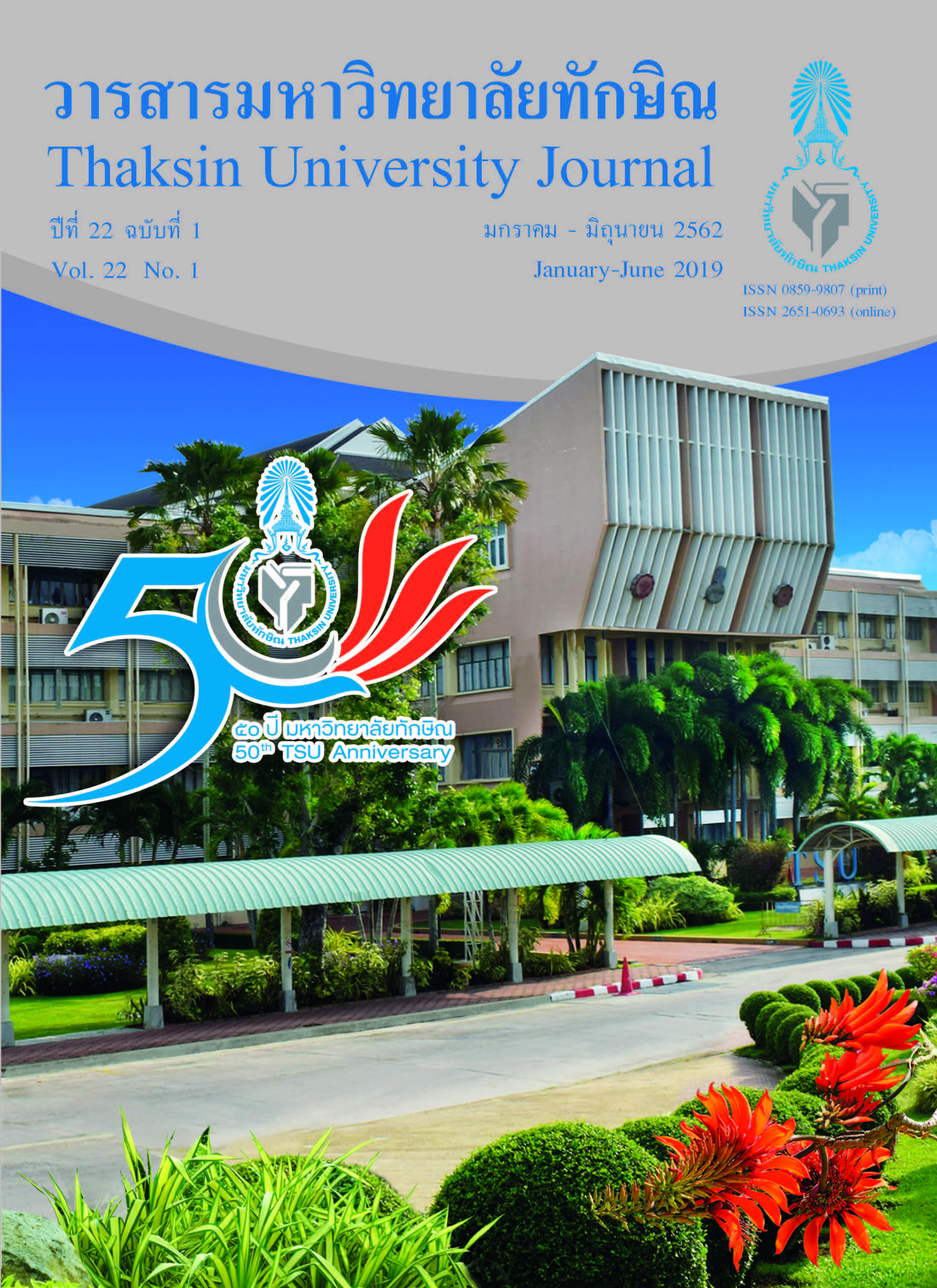Prevalence of Work-Related Musculoskelatal Disorders in Walailak University’s Personnel
Main Article Content
Abstract
The study is to reveal the relationship between the musculoskeletal disorder and abnormalities
among the office workers. The 101 participants who had age range 20-60 years completed questionnaires and then were assessed to explore the musculoskeletal disorder and abnormalities. It was found that the most three pain areas were at shoulder, neck and back. The most forth abnormalities were myofascial pain, low back pain, de quervain's tenosynovitis and nerve tension, respectively. The severity of symptom was stage 1 ( fatigue during work time, symptoms disappear during night time or rest, no working ability decrease, having symptoms for week or month and having off and on.) Relationships between work experience and pain area were significantly correlated.
Article Details

This work is licensed under a Creative Commons Attribution-NonCommercial-NoDerivatives 4.0 International License.
References
Disorders among Sugarcane Farmers in North-eastern Thailand. Asia Pacific Journal of Public
Health, 26(3), 320-327.
[2] Ranasinghe, P., Perera, Y. S., Lamabadusuriya, D. A., Kulatunga, S., Jayawardana, N., Rajapakse, S., &
Katulanda, P. ( 2011) . Work Related Complaints of Neck, Shoulder and Arm among Computer
Office Workers: A Cross-sectional Evaluation of Prevalence and Risk Factors in a Developing
Country. Environmental Health, 10(1), 1-9.
[3] Punnett, L., & Wegman , D. H. (2004). Work-related Musculoskeletal Disorders: The Epidemiologic
Evidence and the Debate. Journal of Electromyography and Kinesiology, 14(1), 13-23.
[4] Aghili, M., Asilian, H., & Poursafa, P. (2012). Evaluation of Musculoskeletal Disorders in Sewing Machine
Operators of a Shoe Manufacturing Factory in Iran. Journal of the Pakistan Medical Association,
62(3), 20-25.
[5] Kroemer, K. H. E. (2003). Cumulative Trauma Disorders: Their Recognition and Ergonomics Measures to
Avoid them. Applied Ergonomics, 20(4), 274-280.
[6] Kee, D., Chung, M. K. & Kim, J. H. (2011). Legal System and Its Effect for Prevention of Work-related
Musculoskeletal Disorders in Korea. International Journal of Industrial Ergonomics, 41( 3) ,
224-232.
[7] Reilly T. ( 2002) . Musculoskeletal Disorders in Health-related Occupations. Biomedical and Health
Research, 49(1), 206
[8] Santipong, K. (2008). Injuries from Repetitive Work Situations (Online). Retrieved 18 December 2017, from
http://www. infku.ac.th/ article/diag/510202/ctd.html.
[9] Andersen, J. H., Kaergaard, A., Mikkelsen, S., Jensen, U. F., Frost, P., Bonde, J. P., & Thomsen, J. F.
(2003). Risk Factors in The Onset of Neck/Shoulder Pain in a Prospective Study of Workers in
Industrial and Service Companies. Occupational and Environmental Medicine, 60(1), 649.-654.
[10] Ekpenyong, C. E., & Inyang, U. C. (2014). Associations between Worker Characteristics, Workplace
Factors, and Work-related Musculoskeletal Disorders: A Cross-Sectional Study of Male
Construction Workers in Nigeria. International Journal of Occupational Safety and Ergonomics,
20(3), 447-462.
[11] Oha, K., Animägi, L., Pääsuke, M., Coggon, D., & Merisalu, E. (2014). Individual and Work Related
Risk Factors for Musculoskeletal Pain: a Cross-sectional Study among Estonian Computer Users.
BMC Musculoskeletal Disorders, 15(1), 1-5.
[12] Kaliniene, G., Ustinaviciene, R., Skemiene, L., & Januskevicius, V. (2013). Associations between Neck
Musculoskeletal Complaints and Work Related Factors among Public Service Computer Workers in
Kaunas. International Journal of Occupational Medicine and Environmental Health, 26(5), 670-681.
[13] Dianat, I., Kord, M., Yahyazade, P., Karimi, M. A., & Stedmon, A.W. (2015). Association of Individual
and Work-related Risk Factors with Musculoskeletal Symptoms among Iranian Sewing Machine
Operators. Applied Ergonomics, 51(1), 180-188.
[14] Phonharn, N., Ruengvoraboon, S., Boonkaew, K., & Seewirat, A. (2014). The Physical Symptoms that Occur
from Using Computer of Supporting Staffs of Nakhon Phanom University. Srinakharinwirot
University (Journal of Science and Technology), 6(12), 26-38.
[15] Krusun, M., & Chaiklieng, S. (2014). Ergonomic Risk Assessment in University Office Workers. KKU
Research Journal, 19(5), 696 -707.
[16] Mekhora, K., Kurustien, N. B., & Klangsin, P. (2008). Specific Exercise to Reduce WMSDs among
Computer Users. The 9th Southeast Asian Ergonomics Conference, Bangkok, Thailand.
[17] Kang, J. H., Park, R. Y., Lee, S. J., Kim, J. Y., Yoon, S. R., & Jung, K. I. ( 2012). The Effect of the Forward
Head Posture on Postural Balance in Long Time Computer Based Worker. Annals of Rehabilitation
Medicine, 36(1), 98-104.
[18] Chaffin, D. B. (1973). Localized Muscle Fatigue - definition and Measurement. Journal of Occupational
and Environmental Medicine, 15(4), 346-354.
[19] Beach, T. A. C., Parkinson, R. J., Stothart, J. P., & Callaghan, J. P. (2005). Effects of Prolonged Sitting
on the Passive Flexion Stiffness of the in Vivo Lumbar Spine. The Spine Journal, 5(2), 145-154.
[20] Chaikan, W., Janprasit, C., & Keawthammanukul, T. (2007). Ergonomic Factors and Prevalence Rate of
Musculoskeletal Pain among Workers in Semiconductor Industry in the Northern Region
Industrial Estate. Journal of Health Science, 16(2), 226-233.
[21] Klussmann, A., Gebhardt, H., Liebers, F. & Rieger, M.A. (2008). Musculoskeletal Symptoms of the Upper
Extremities and the Neck: A Cross-Sectional Study on Prevalence and Symptom-predicting Factors
at Visual Display Terminal (VDT) Workstations. BMC Musculoskeletal Disorders, 9(1), 1-16.
[22] Health Information System Development Office. (2003). Keeping Healthy with Computer Use (Online).
Retrieved 21 December 2017, from http://www.hiso.or.th/hiso/health_news/health_story4_19.php.
[23] Ketola, R. (2004). Physical Workload as a Risk Factor for Symptoms in the Neck and Upper Limbs:
Exposure Assessment and Ergonomic Intervention. Journal of Sports Science and Medicine,
3(1), 1-46.
[24] Vinyoocharoenkul, J., & Pochana, K. (2015). The Ergonomic Risk Assessment of Computer User by Rapid
Office Strain Assessment (ROSA). Journal of Public Health, 45(2), 148-158.
[25] Marras, W. S. (2000). Occupational Low Back Disorder Causation and Con
trol. Ergonomic, 43(3), 880-902.
[26] Jantratap, P., & Chaiklieng, S. (2011). Prevalence and Risk Factors of Musculoskeletal Disorders among
Solid Waste Collectors Employed by the Local Administrative Organizations at Nong Bua Lam
Phu Province. KKU Journal for Public Health Research, 4(2), 49-58.
[27] Boonprakob, Y., Phadungkit, S., Nongharnpitak, S., Srijessadarak, T., Supasatean, W., & Nakhengrit, C.
( 2016). Trigger Point: Curable or Palliative Symptoms. Bulletin of Chiang Mai Associated
Medical Sciences, 49(1), 155-166.


